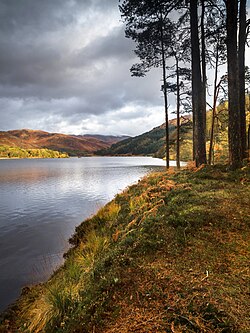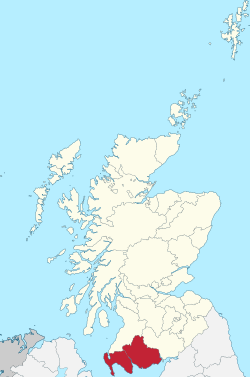
Back Gall-Ghaidhealaibh Breton Galloway Catalan Galloway Czech Galloway Welsh Galloway Danish Galloway (Schottland) German Galloway Spanish Galloway Basque گالووی Persian Galloway French
Galloway | |
|---|---|
 | |
 Galloway (red) shown in Scotland (pink) shown in the United Kingdom (light grey) | |
| Demonym | Gallovidian |
Galloway (Scottish Gaelic: Gall-Ghàidhealaibh [ˈkal̪ˠaɣəl̪ˠu]; Scots: Gallowa; Latin: Gallovidia)[1] is a region in southwestern Scotland comprising the historic counties of Wigtownshire and Kirkcudbrightshire. It is administered as part of the council area of Dumfries and Galloway.
Galloway is bounded by sea to the west and south, the Galloway Hills to the north, and the River Nith to the east; the border between Kirkcudbrightshire and Wigtownshire is marked by the River Cree. The definition has, however, fluctuated greatly in size over history.
A native or inhabitant of Galloway is called a Gallovidian.[2][3] The region takes its name from the Gall-Gàidheil, or "stranger Gaels", a people of mixed Gaelic and Norse descent who seem to have settled here in the 10th century.[4] Galloway remained a Gàidhealtachd area for much longer than other regions of the Scottish Lowlands and a distinct local dialect of the Scottish Gaelic language survived into at least the 18th century.
A hardy breed of black, hornless cattle named Galloway cattle is native to the region, in addition to the more distinctive Belted Galloway or "Beltie".
- ^ Andy Eagle (27 February 2003). "The Online Scots Dictionary". Scots-online.org. Archived from the original on 8 July 2010. Retrieved 18 June 2014.
- ^ "Gallovidian". Dictionary.com. n.d. Retrieved 27 September 2016.
{{cite web}}: CS1 maint: year (link) - ^ "Gallovidian, adj. and n." OED Online. n.d. Retrieved 18 September 2016.
{{cite web}}: CS1 maint: year (link) - ^ Jennings, Andrew (1993). An Historical Study of the Gael and Norse in Western Scotland from c. 795 to c. 1000 (PhD thesis). The University of Edinburgh. pp. 138–146.